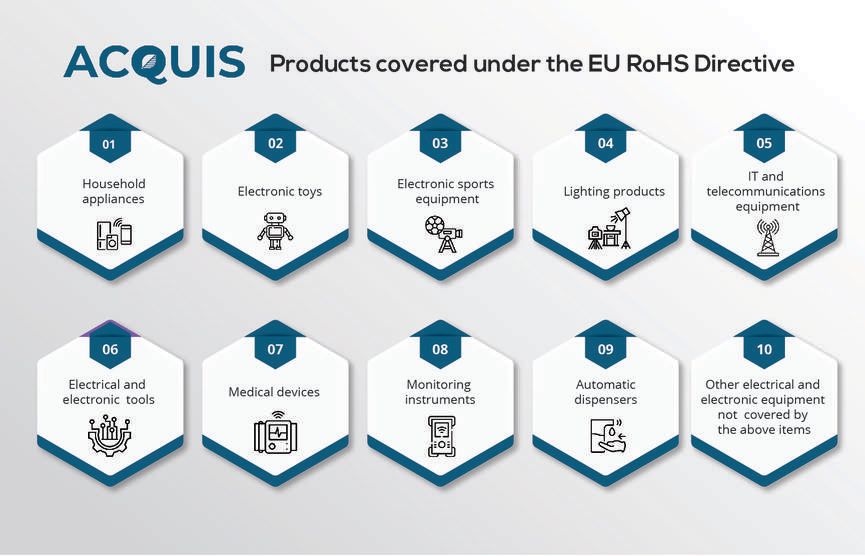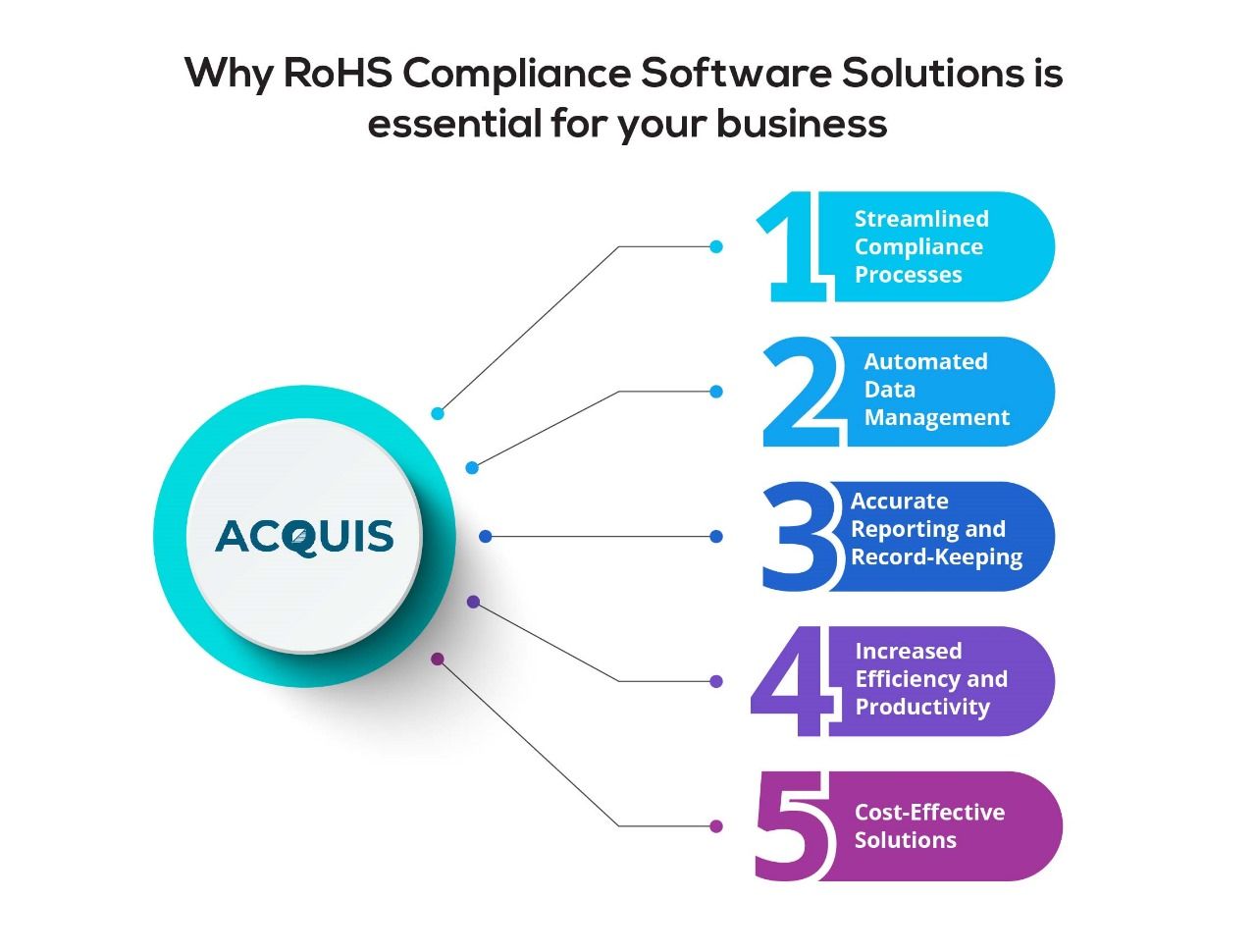Table of Contents
What is the EU RoHS Directive?
RoHS (Restriction of Hazardous Substances) is a regulation impacting the electronics industry and a broad range of electrical products. The original RoHS, formally known as Directive 2002/95/EC, was introduced by the European Union in 2002. This directive restricted the use of six hazardous materials in electrical and electronic products, ensuring that any applicable product sold in the EU market since July 1, 2006, must comply with these restrictions to be RoHS compliant. There have been significant amendments to this regulation since 2002. Let's dive deep into the EU RoHS Directive to understand this regulation better.
Evolution of restricted substances under EU RoHS Directive
- RoHS Directive 2002/95/EC
Introduction: Enacted in 2002. Implementation: Enforced from July 1, 2006. Restricted Substances: Six hazardous materials:
- Lead (Pb)
- Mercury (Hg)
- Cadmium (Cd)
- Hexavalent chromium (Cr6+)
- Polybrominated biphenyls (PBB)
- Polybrominated diphenyl ethers (PBDE)
- RoHS Directive 2011/65/EU
Publication: 2011.
Key Changes:
-
Introduced a CE-marking directive, making RoHS compliance necessary for CE marking of products.
-
Added Categories 8 (medical devices) and 9 (monitoring and control instruments) to the scope.
-
Enhanced compliance recordkeeping requirements, ensuring better traceability and accountability.
-
Came into effect on January 2, 2013.
-
RoHS Directive 2015/863:
Key Changes:
Added four additional restricted substances, specifically phthalates, to the original list of six:
- Bis(2-ethylhexyl) phthalate (DEHP)
- Benzyl butyl phthalate (BBP)
- Dibutyl phthalate (DBP)
- Diisobutyl phthalate (DIBP) Aimed to address the potential risks posed by these substances, particularly their impact on human health and the environment.
- RoHS Directive (EU) 2024/232:
Key Changes:
Amendments to substance restrictions, exemption rules, and compliance procedures
Proposed Substances Addition:
- Antimony trioxide (ATO)
- Tetrabromobisphenol A (TBBP-A) If approved, the total number of restricted substances will increase from 10 to 12.
What is the Scope of the EU RoHS Directive
The EU RoHS Directive applies to any company manufacturing or importing finished EEE products into the EU. To be considered EEE, products must be either dependent on electrical currents or electromagnetic fields to function properly or else must be equipment used for the generation, transfer, and measurement of such currents and fields.
Products covered under the EU RoHS Directive

What is the EU RoHS Exemption List?
A group of specific applications and industries that are exempted from the restrictions on the use of certain hazardous substances under the EU RoHS Directive. The EU RoHS Exemption List currently contains over 100 exemptions, covering a wide range of applications and industries, such as medical devices, military equipment, and the aerospace industry.
Products exempted under the EU RoHS directive
- Equipment for military purposes.
- Equipment for space use.
- Large-scale stationary industrial tools.
- Active implantable medical devices.
- Equipment designed solely for research and development and provided only on a business-to-business basis.
Why does the EU for Hazardous Substances grant Exemptions under RoHS
RoHS exemptions are not blanket permissions. They are carefully scoped allowances granted when eliminating a hazardous substance is not technically or scientifically feasible — or when substitution would compromise product performance, safety, or reliability.
The European Commission follows a formal process, including:
- Technical evaluations
- Industry consultations
- Feasibility studies
Each exemption has a specific use case and an expiry date. To remain valid, it must be reapplied for and justified based on the latest data and technological progress.
These exemptions ensure that RoHS compliance evolves responsibly while allowing industry time to innovate.
How RoHS Exemptions Have Expired Over Time
As technology advances, many RoHS exemptions that were once necessary have been phased out. For instance:
- Cadmium in display lighting was once exempted but later banned as LED alternatives matured.
- Mercury in certain compact fluorescent lamps (CFLs) is no longer allowed in most applications.
- Several exemptions related to lead in solders and alloys have been narrowed or removed entirely.
The European Commission regularly reviews active exemptions to assess whether viable substitutes now exist. If so, the exemption is either not renewed or redefined with stricter conditions.
Manufacturers relying on older exemptions must stay ahead of changes to avoid non-compliance during audits or market entry.
RoHS Technical Documentation Requirement
EN IEC 63000:2018: This standard guides the technical documentation for evaluating EEE products. It’s the only active harmonized standard since EN 50581 was withdrawn.
Key Objectives of EN IEC 63000:2018
- Standardizes the technical documentation process for RoHS compliance.
- Establishes a risk-based approach to evaluating hazardous substances.
- Aligns with global environmental regulations beyond just EU RoHS.
- Provides a due diligence framework to assess suppliers and materials.
- Incorporates the latest compliance exemptions, such as those for cadmium and lead in recovered rigid PVC, introduced in Directive (EU) 2024/232 (valid until May 28, 2028).
- Accounts for the evolving status of RoHS exemptions — Several exemptions have already expired as safer alternatives became available.
- For example, cadmium in display lighting and mercury in CFLs are now restricted.
- Lead exemptions for certain solders have been narrowed or removed in recent years.
- Exemptions must be monitored closely to ensure they remain valid for your application.
Staying up to date with RoHS exemption revisions is essential to ensure your technical file remains valid under EN IEC 63000:2018 requirements.
Conformity Assessment under the EU RoHS directive
Module A in Annex II: Manufacturers must conduct a conformity assessment without involving a notified body. This assessment covers:
- Manufacturing Process and Monitoring: Manufacturers must monitor their production process to ensure compliance.
- Technical Documentation: Manufacturers must maintain technical documentation, including product descriptions, designs, standards used, and test reports, for ten years after placing the product on the EU market.
- CE Marking: Products must bear the CE mark to indicate compliance with RoHS requirements.
- Declaration of Conformity (DoC): Manufacturers must issue a DoC before placing products on the EU market. The DoC should include product information, compliance statement, standards used, and issuer's details.
Note on Exemptions Frequently Included in DoC Filings Certain exemptions are frequently referenced in technical documentation and Declarations of Conformity. These include:
- Lead in high melting temperature solders (Exemption 7(a))
- Lead in steel (6(a)), aluminum (6(b)), and copper alloys (6(c))
- Cadmium in optical components
- Hexavalent chromium in surface coatings
These exemptions are typically extended due to the absence of functionally equivalent and commercially viable alternatives. Manufacturers relying on them must clearly document their application scope and track sunset dates closely.
Including valid exemption references in your DoC and technical file is essential to avoid rejection during audits or customs checks.
List of Technical Documentation for Conformity Assessment under the EU RoHS directive
- Product description.
- Concept design, manufacturing drawings, and schemes.
- Description of designs and drawings.
- List of harmonized standards or technical specifications.
- Calculations and examination outcomes.
- Test reports.
List of Declaration of Conformity (DoC) Documentation
- Unique identifier for the electrical and electronic equipment.
- Manufacturer's name and address.
- Statement asserting the manufacturer's responsibility for the DoC.
- Product traceability information.
- Statement declaring compliance with RoHS requirements.
- List of relevant harmonized or technical standards.
- Place and date of issue.
- Name and signature of the issuer.
Labeling Requirement under EU RoHS Directive
To comply with RoHS directives, importers and manufacturers must ensure proper labeling on their products, packaging, and accompanying documents, including CE markings and product traceability information:
CE Marking
- Requirement: Electrical and electronic equipment covered by RoHS must bear the CE marking.
- Placement: CE marking should be affixed clearly, understandably, and permanently. If not feasible due to product's nature, it must be on packaging and accompanying documents.
Product Traceability
Information Required:
- Type, batch, or serial number for identification.
- Name, registered trade name, or trademark of importer or manufacturer.
- Address and contact information of importer or manufacturer.
How to Meet EU RoHS Directive Requirements with Compliance Automation
Acquis simplifies RoHS compliance by centralizing supply chain data management. Our RoHS Compliance Software automates supplier engagement, data collection from large supply chains, and validates it using advanced machine learning. It then organizes data into customizable reports for easy analysis. Making your product effortlessly compliant and ready for global market access.

Stay ahead of RoHS regulations — streamline your exemption tracking and documentation with Acquis.
Talk to our compliance experts today and discover how automation can simplify your RoHS strategy.
